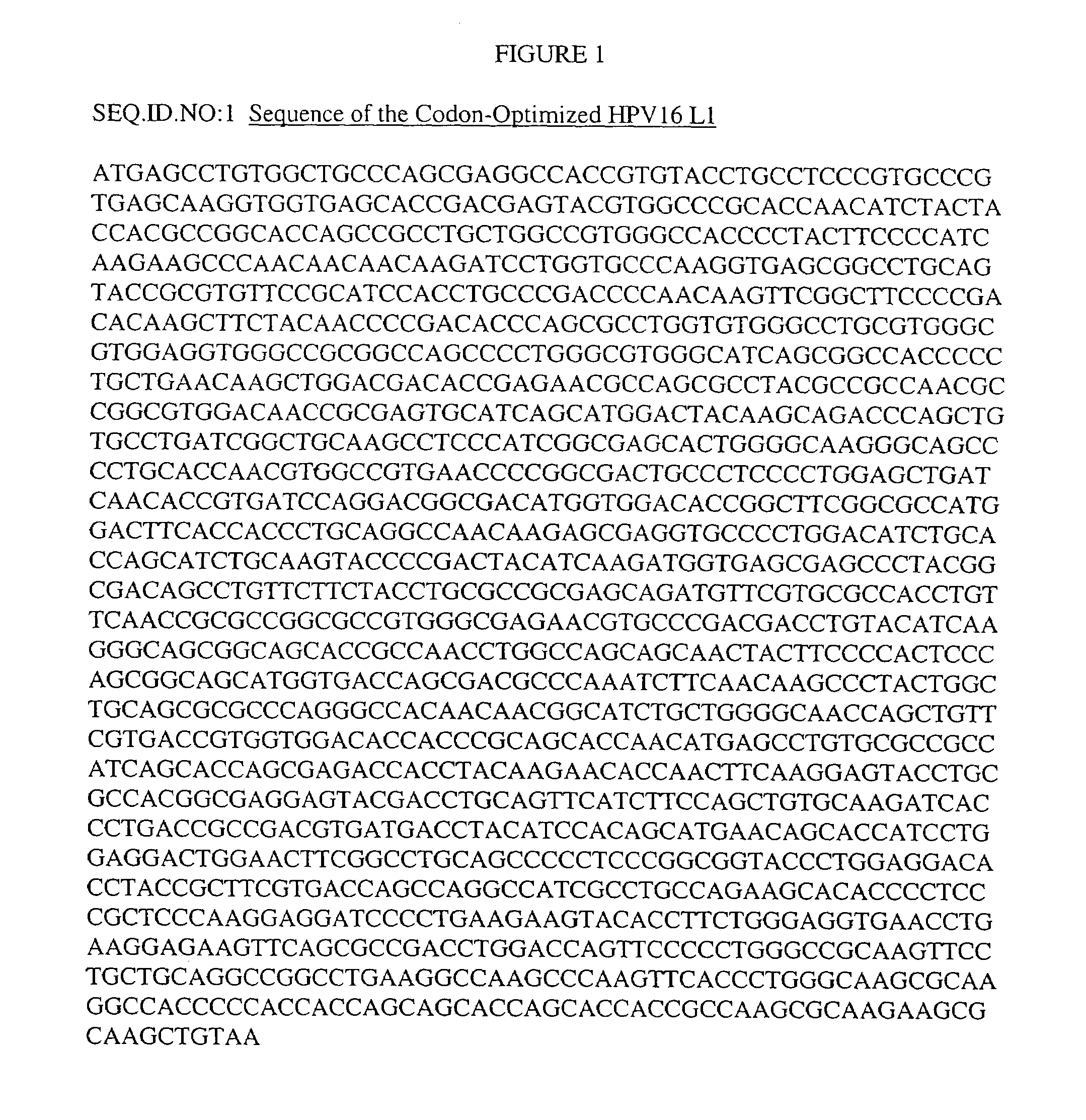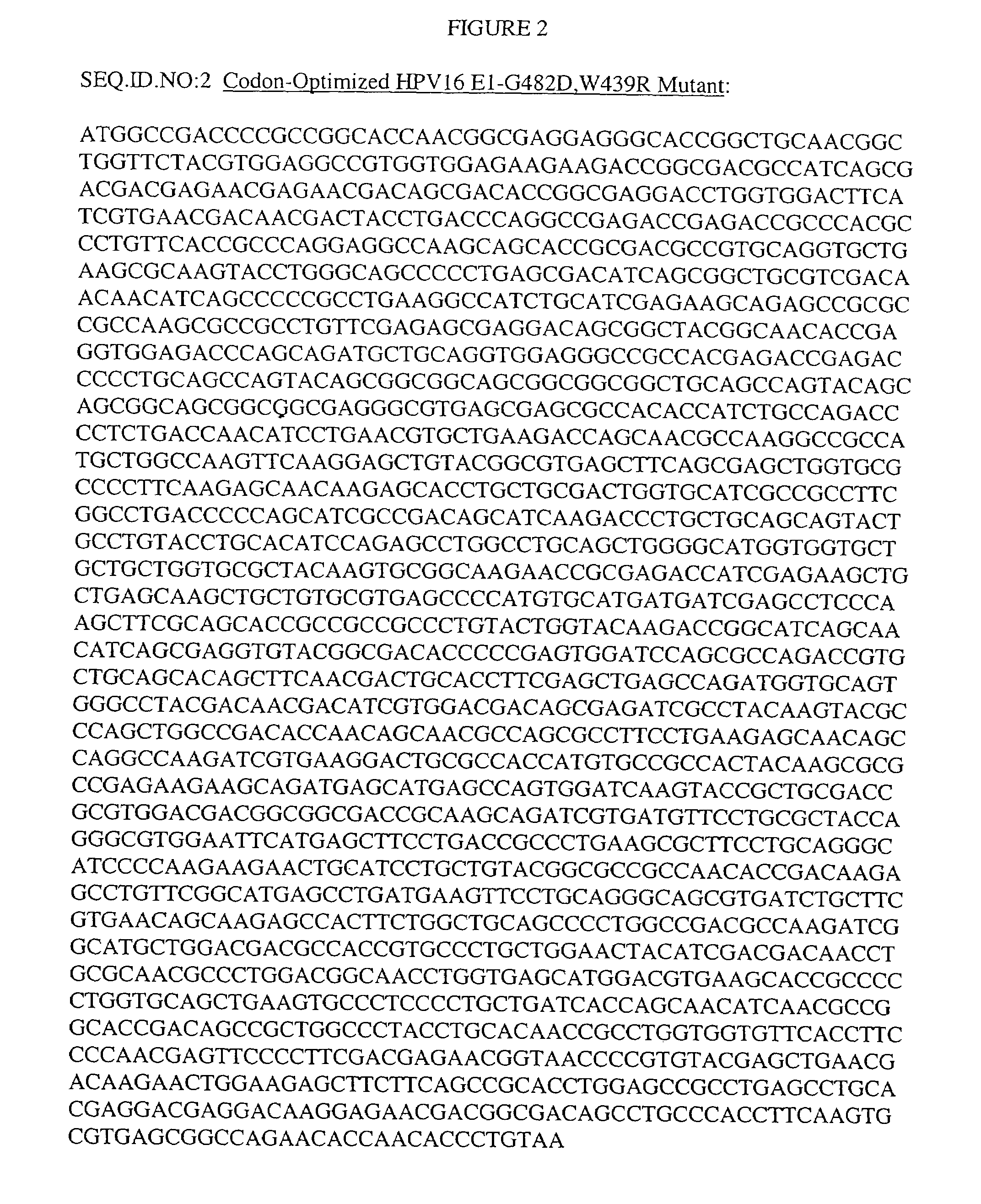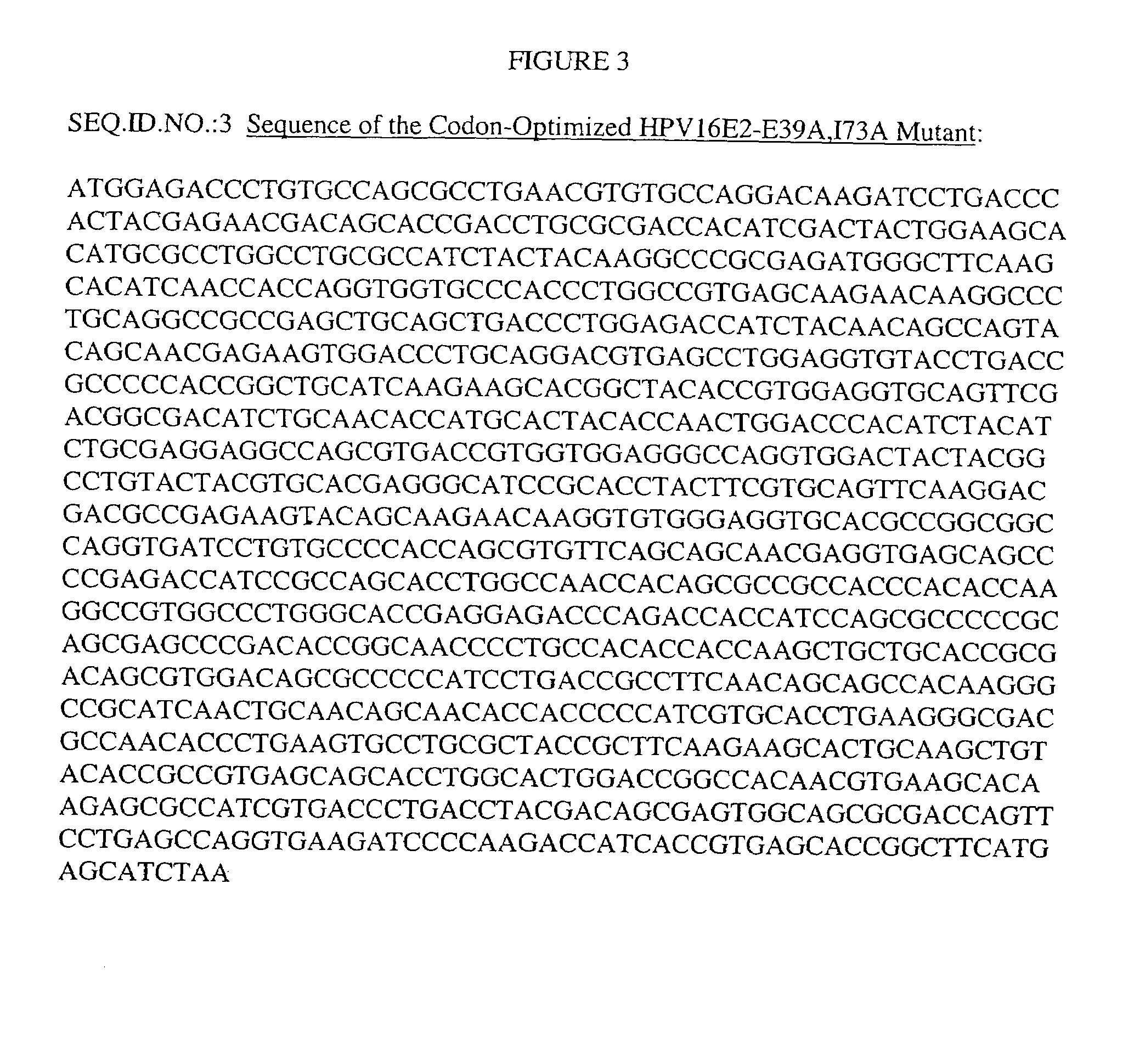Synthetic human papillomavirus genes
a human papillomavirus and synthetic technology, applied in the field of synthetic human papillomavirus genes, can solve the problems of inability to generate an effective hpv vaccine, inability to meet the needs of patients, etc., to achieve the effect of convenient insertion, removal or replacemen
- Summary
- Abstract
- Description
- Claims
- Application Information
AI Technical Summary
Benefits of technology
Problems solved by technology
Method used
Image
Examples
example 1
Synthetic Gene Construction
[0094]Synthetic gene sequences for human papillomavirus proteins L1, E1, E2, and E7 were generated by reverse translation of amino acid sequences using the most frequently used codons found in highly expressed mammalian genes. (R. Lathe, 1985, J. Mol. Biol. 183:1–12, which is hereby incorporated by reference). Some adjustments to these codon-optimized sequences were made to introduce or remove restriction sites. Oligonucleotides based on these sequences were chemically synthesized (Midland Certified Reagents; Midland, Tex.) and assembled by PCR amplification. (J. Haas et. al., 1996, Current Biology 6:315–324; and PCR Protocols, M. Innis, et al, eds., Academic Press, 1990, both of which are hereby incorporated by reference).
[0095]Full-length sequences were cloned into the mammalian expression vector V1Jns (J. Shiver et. al. 1996, in DNA Vaccines, eds., M. Liu, et al. N.Y. Acad. Sci., N.Y., 772: 198–208, which is hereby incorporated by reference) and sequenc...
example 2
Synthesis of HPV 16 L1
[0097]The gene encoding HPV16 L1 was prepared by the annealing and extension of the 14 oligomers listed in FIG. 17. Five separate extension reactions were performed to create fragments of the gene, designated L1A, L1B, L1C, L1D and L1E by PCR using conditions similar to those described in EXAMPLE 3 and 4, below.
[0098]L1A was constructed using oligomer sequences MN4A1 (SEQ.ID.NO:9), MN4A2 (SEQ.ID.NO:16) and MN4A3 (SEQ.ID.NO:10) which were amplified using the oligomers MN604 (SEQ.ID.NO:32) and MN596 (SEQ.ID.NO:24).
[0099]L1B was constructed using oligomer sequences MN4A4 (SEQ.ID.NO:17), MN4A5 (SEQ.ID.NO:11) and MN4A6 (SEQ.ID.NO:18) and were amplified using the oligomers MN595 (SEQ.ID.NO:23) and MN598 (SEQ.ID.NO:26).
[0100]L1C was created using oligomer sequences MN4A7 (SEQ.ID.NO:12) and MN4A8 (SEQ.ID.NO:19) and were amplified using the oligomers MN597 (SEQ.ID.NO:25) and MN602 (SEQ.ID.NO:30).
[0101]L1D was created using oligomer sequences MN4A9 (SEQ.ID.NO:13), MN4A10...
example 3
Synthesis of HPV 16 E1
[0105]The gene encoding the modified form of HPV16 E1 was assembled from a series of fragments: E1A, E1B, E1C, E1D, E1E and E1F, using the oligomers listed in FIG. 18. E1A was formed by assembly of oligomers MN605 (SEQ.ID.NO:33), MN606 (SEQ.ID.NO:34) and MN607 (SEQ.ID.NO:35) and amplified using oligomers MN636 (SEQ.ID.NO:64) and MN624 (SEQ.ID.NO:52).
[0106]E1B was formed by assembly of oligomers MN608 (SEQ.ID.NO:36), MN609 (SEQ.ID.NO:37) and MN610 (SEQ.ID.NO:38) which were amplified with oligomers MN623 (SEQ.ID.NO:51) and MN626 (SEQ.ID.NO:54).
[0107]E1C was formed by assembly of oligomers MN611 (SEQ.ID.NO:39) and MN612 (SEQ.ID.NO:40) which were amplified with oligomers MN625 (SEQ.ID.NO:53) and MN628 (SEQ.ID.NO:56).
[0108]E1D was formed by assembly of oligomers MN613 (SEQ.ID.NO:41), MN614 (SEQ.ID.NO:42) and MN615 (SEQ.ID.NO:43) which were amplified with oligomers MN627 (SEQ.ID.NO:55) and MN630 (SEQ.ID.NO:58).
[0109]E1E was formed by assembly of oligomers MN616 (SEQ....
PUM
| Property | Measurement | Unit |
|---|---|---|
| time | aaaaa | aaaaa |
| time | aaaaa | aaaaa |
| time | aaaaa | aaaaa |
Abstract
Description
Claims
Application Information
 Login to View More
Login to View More - R&D
- Intellectual Property
- Life Sciences
- Materials
- Tech Scout
- Unparalleled Data Quality
- Higher Quality Content
- 60% Fewer Hallucinations
Browse by: Latest US Patents, China's latest patents, Technical Efficacy Thesaurus, Application Domain, Technology Topic, Popular Technical Reports.
© 2025 PatSnap. All rights reserved.Legal|Privacy policy|Modern Slavery Act Transparency Statement|Sitemap|About US| Contact US: help@patsnap.com



